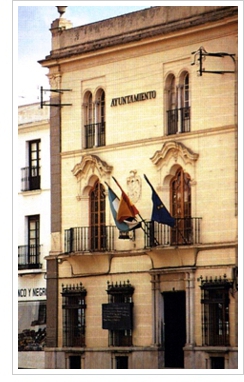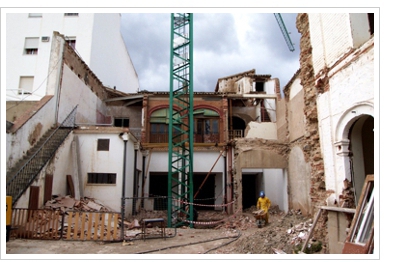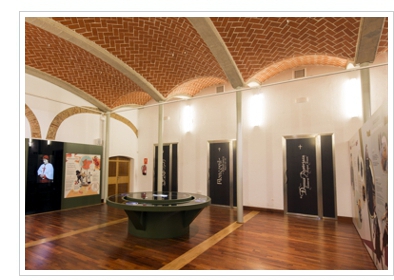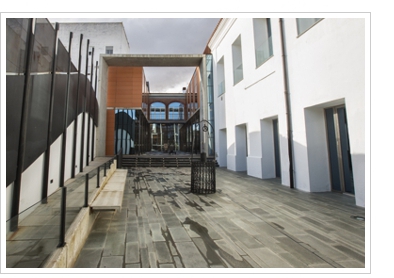|
||||
|---|---|---|---|---|
 Visiting the Museum of Villafranca de los Barros (MUVI) is essential for getting to to know about the past of this town, wich is located in the heart of Tierra de Barros. A historical walk from the Palaeolithic up to present day is possible in the Museum, where you can enjoy the perfect combination of modern architecture and culture. But the MUVI isn’t merely local area. It offers a historical tour, of the past of this city and its surroundings, bringing its visitors the chance to learn about Extremadura, Spain and human history evolution.
Visiting the Museum of Villafranca de los Barros (MUVI) is essential for getting to to know about the past of this town, wich is located in the heart of Tierra de Barros. A historical walk from the Palaeolithic up to present day is possible in the Museum, where you can enjoy the perfect combination of modern architecture and culture. But the MUVI isn’t merely local area. It offers a historical tour, of the past of this city and its surroundings, bringing its visitors the chance to learn about Extremadura, Spain and human history evolution.
The lifestyles of the given periods are shown through images, objects, technologies, and areas full of memory. A compendium of technological, interactive, audiovisual and textual resources that relate documented stories of the inhabitants of Villafranca de los Barros, together with many pieces that help the visitors to contextualize the different time periods during the tour.
The building was built in the XVIII century. It’s a clear example of for an upper-middle class living house in this part of Extremadura. Fifty years ago, the house was turned into the local Town hall. Nowadays the building has been remodeled and harbours the Museum, with three floors and thirteen exhibition rooms, moreover there is an independent, modern building with four floors used to show antique vehicles.
 The archaeological discoveries found in Villafranca and in the surroundings date back to the Palaeolithic period, thanks to archaeological digs, it’s possible to know the first human settlements in this area on the spot. Original pieces, copies, audiovisuals, information boards have been brought to the display elements cabinet of the Museum to show us the most ancient history of this town.
The archaeological discoveries found in Villafranca and in the surroundings date back to the Palaeolithic period, thanks to archaeological digs, it’s possible to know the first human settlements in this area on the spot. Original pieces, copies, audiovisuals, information boards have been brought to the display elements cabinet of the Museum to show us the most ancient history of this town.
The Palaeolithic, the Bronze Age, the Iron Age and the Roman period continue this tour along the exhibition rooms of the Museum. Different life aspects in this zone are shown, in this concrete case through the burials, individuals or collective graves and funeral monuments.
 During the Roman times Villafranca was named Perceiana. This place was located next to the road called "Vía de la Plata", which is an ancient commercial and pilgrimage path that crosses the west of Spain from north to south, connecting Emerita (Mérida) to Italica. The importance of Villafranca in this period is shown in one of the exhibition rooms in the museum where you can learn about the traditional roman houses (villae), several coins and objects from this period.
During the Roman times Villafranca was named Perceiana. This place was located next to the road called "Vía de la Plata", which is an ancient commercial and pilgrimage path that crosses the west of Spain from north to south, connecting Emerita (Mérida) to Italica. The importance of Villafranca in this period is shown in one of the exhibition rooms in the museum where you can learn about the traditional roman houses (villae), several coins and objects from this period.
Moving along the Middle and Modern ages, when Villafranca was named Moncovil, you can appreciate different aspects of these periods and the contribution of Villafranca to the history.
In the museum there is also an exhibition room devoted to agriculture due to the agricultural tradition that Extremadura has had for many centuries and which has resulted in agricultural and stock breeding methods that are at one with nature and that are displayed in the room too. Furthermore, you can find a room housing very well known embroideries from Villafranca. The embroidery tradition still persists nowadays in the town thanks to the local families perseverance in keeping such an ancient art.
The music stands out among other arts. Music, both classical and popular, has been closely linked to the history of Villafranca. Each row championed by two eminent figures Pedro Bote and Pedro Cortés Gallardo. In this room, visitors can enjoy musical instruments and audiovisual and touchable elements.
 At the end of the XIX century, Villafranca got the title of city from the King Alfonso XII. Throughout the XX century room, the Museum exhibits all the main political, cultural and different events that took place in our country and in Europe, displayed with small and big objects, photos, and an educational film. Moreover, in this huge room you can also admire the amazing painting “Diez Metros de Historia” made by our local painter Jose Mª Larrondo. In the third floor of the main building, there is a room with books, newspapers, magazines, educational and religious books, and some technical or scientific documents…
At the end of the XIX century, Villafranca got the title of city from the King Alfonso XII. Throughout the XX century room, the Museum exhibits all the main political, cultural and different events that took place in our country and in Europe, displayed with small and big objects, photos, and an educational film. Moreover, in this huge room you can also admire the amazing painting “Diez Metros de Historia” made by our local painter Jose Mª Larrondo. In the third floor of the main building, there is a room with books, newspapers, magazines, educational and religious books, and some technical or scientific documents…
A specific part of the Museum is devoted to vehicles. Here you can find some models from the first part of the XX century to the last decades. The collection shows the historical evolution through cars and motorbikes.
